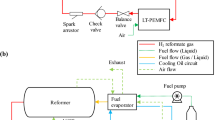Abstract
Electrochemical characteristics of single cell performances at various humidity conditions and constant temperatures of 40−100 °C using membrane electrode assemblies (MEAs) were studied. The MEAs consist of alternative proton-conducting hybrid membrane electrolyte and noble Pt/C catalyst for the H2/O2 proton exchange membrane fuel cells (PEMFCs). The function of humidity on the cell performances was investigated at larger current density values of 501 mA cm−2 and constant cell temperatures of 80 and 90 °C and the relative humidity of 100 %. The power density value of 400 mW cm−2 was obtained when the same MEA at similar operating conditions was used. The effects of temperature on the single cell performances were investigated at various temperature ranges of 40–100 °C and constant relative humidity of 50, 70, and 100 %. The maximum current density and power density values of about 600 mA cm−2 and 160 mW cm−2, respectively, were obtained at 90 °C with 100 % RH. The results were compared with the reported results of Nafion membrane and similar hybrid membranes operating at low temperatures for H2/O2 fuel cells. Finally, the results provided an alternative proton-conducting electrolyte as promising candidate for low/intermediate temperature operating H2/O2 fuel cells.







Similar content being viewed by others
References
Savadogo O (1998) J New Mater Electrochem Syst 1:47–66
Zawodzinski TA, Neeman M, Sillerud LO, Gottesfeld S (1991) J Phys Chem 95:6040–6044
Sone Y, Ekdunge P, Simonsson D (1996) J Electrochem Soc 143:1254–1259
Silva RF, De Francesco M, Pozio A (2004) J Power Sources 134:18–26
Fontanella JJ, Edmondson CA, Wintersgill M, Wu Y, Greenbaum SG (1996) Macromolecules 29:4944–4951
Miyateke K, Shouji E, Yamamoto K, Tsuchida E (1997) Macromolecules 30:2941–2946
Wycisk R, Pintauro PN (1996) J Membr Sci 199:155–160
Wang F, Chen T, Xu J (1998) Macromol Rapid Commun 19:135–137
Nikitina TS (1990) Russ Chem Rev 59:575–589
Przyluski J, Poltarzewski Z, Wieczorek W (1998) Polymer 39:4343–4347
Uma T, Nishina Y, Kimura K, Hayakawa S, Bobba R (2012) Mater Lett 81:88–91
Pivovar B, Wang YX, Cussler E (1999) J Membr Sci 154:155–162
Alkire RC, Gerischer H, Kolb DM, Tobias CW (eds) (1997) Advances in electrochemical science and engineering, vol. 5, 1st edn. Wiley, Weinheim
Uma T, Nogami M (2012) J Membr Sci 411:109–116
Jung DH, Cho SY, Peck DH, Shin DR, Kim JS (2002) J Power Sources 106:173–177
Helen M, Viswanathan B, Srinivasa Murthy S (2006) J Power Sources 163:433–439
Srinivasan S, Ticianelli EA, Derouin CR, Redondo A (1988) J Power Sources 22:359–375
Acknowledgments
This work was financially supported by the Ministry of Education, Sport, Culture, Science and Technology (MEXT) and the Special Coordination Funds for Promoting Sciences and Technology of Japan.
Author information
Authors and Affiliations
Corresponding author
Rights and permissions
About this article
Cite this article
Thanganathan, U., Ghatty, S.L. Effects of humidity and temperature on the electrochemical activities of H2/O2 PEMFCs using hybrid membrane electrolytes. J Solid State Electrochem 18, 285–290 (2014). https://doi.org/10.1007/s10008-013-2278-x
Received:
Revised:
Accepted:
Published:
Issue Date:
DOI: https://doi.org/10.1007/s10008-013-2278-x




